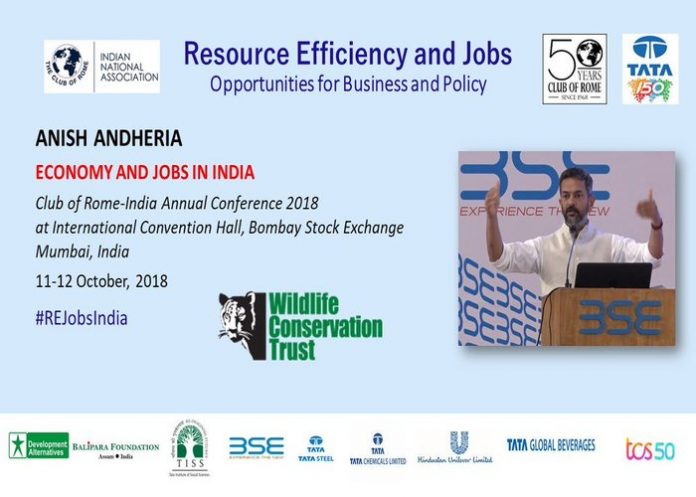Mumbai,November 11, 2018: The Club of Rome Established in 2011, the Indian National Association for the Club of Rome is a non-profit organisation, which aims “to act as a global catalyst for change through the identification and analysis of the crucial problems India is facing and the communication of such problems to the most important public and private decision makers as well as general public.” The broad goal of the national Chapter, CoR-India, is to help design a coherent and synergistic agenda for governments, the business sector as well as citizens’ organisations in India that could ensure a productive resource base and enable everybody in the country to live fuller lives in harmony with their surroundings by the centenary of the nation, 2047.
In 2014, the Indian National Association for the Club of Rome initiated a 5-year series of Annual conferences to examine and analyse the issues of policy coherence in how India manages its key resources. This series was designed to cover the following critical resource issues facing India today:
2014: Food
2015: Water
2016: Forest , Land and soils
2017: Resource Resilience
2018: Jobs and Livelihoods with Resource Efficiency
Resource Efficiency and Jobs :
Resource efficiency and innovation for less damaging resource substitutes, even through automation and mechanisation do not necessarily lead to loss of jobs. Indeed they have historically been seen to create more jobs, particularly requiring higher skills and better pay. India is today among the world’s most rapidly growing economies. It is also home to one of the world’s largest pool of young people looking for jobs. This combination of factors has led many to believe that the “demographic dividend” it produces will automatically drive our nation to the top of the global economic ladder within a few decades. For this dividend not to become a“demographic disadvantage”, let alone a “demographic disaster”, several of our economic, sectoral and social policies will need radical change. Some of these changes are self-evident and generally recognised by government and business leaders; many of them introduced and evolving steadily since the grand liberalisation of 1991. Others are emerging, subsumed under the more recent concerns with raising the “ease of doing business”. While several of these are important and necessary, however, it is less well-understood that they are not at all sufficient.
The national economy unquestionably needs to grow, and to grow rapidly. But its benefits
have also to spread to all our citizens and be sustained for our children and future generations. The basic purpose of national development is, after all, achieving universal human wellbeing and social justice, now and in the future – which are the constitutionally defined goals of our society: GDP growth is simply one of the means to that end, no more important than equity and social fairness, education and participation, nutrition and healthcare, and opportunities for fulfilment and a healthy environment.
Measures to facilitate business activity must, therefore, be complemented by measures that unequivocally raise the quality of life of the poorest half of the economic pyramid and improve the longterm productivity of our natural resource base.
By 2030, India will be the most populous country with over 1.4 billion people surpassing China. More significant, the median age of an Indian will be 32 years in 2030, much younger than of the US with a median age of 39 years, UK (42), Japan (52), and even China (43) or Brazil (35). This means within a decade, India will have the worlds largest youth workforce. This demographic advantage can help propel India’s GDP growth to rate faster than any large economy, including that China, according to most analysts such as Ernst & Young and IHS. Much of this young work force will be absorbed by the fast growing service sector whose share in GDP is anticipated to grow from 57% in FY10 to 68% by FY30, India will still be exporting some 50 million surplus labourers who can migrate to other labour deficit countries.
Our Target:
This may appear ambitious for a country like us which is around 2.8 trillion-dollar economy (GDP)[1] and pushing hard to go neck to neck with our neighbour ‘China’ which is above 14
trillion-dollar economy (GDP)[2] and always having competition to become fastest growing major economies in the world. In this canvas, it is necessary that Indian economy should be sustainable, able to achieve significant growth rate continues for a decade, but at the same time should not be reckless towards the survival of societies, flora and fauna living on this , so while tackling
- Enabling policies for sustainable growth in the job market
- Food and nutrition security of farming households
- Technological upgradation in agriculture sector to increase livelihoods
- Creating job opportunities for marginalised segments
- Effective implementation of zero defect, zero effect and the circular economy
- Facilitating a centralised system of data management – jobs and resources use
- Skill enhancement in MSMEs, maintaining gender balance, social securities, etc.
The Issues which we are covering
Theme 1: Enhancing Future Livelihoods in Rural India and Resource Efficiency
Corporate Comm India(CCI Newswire)




























